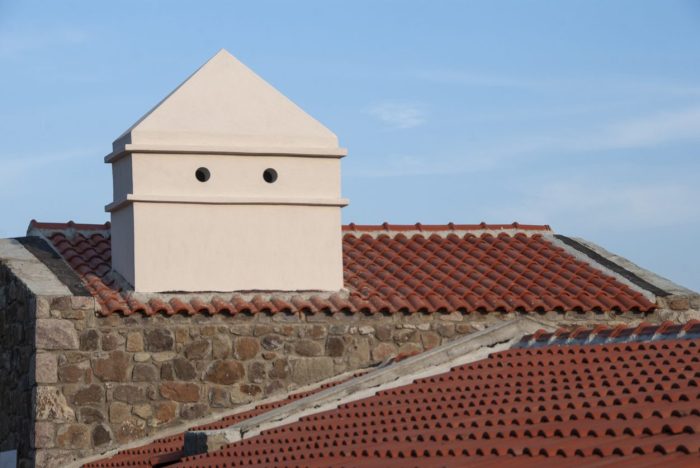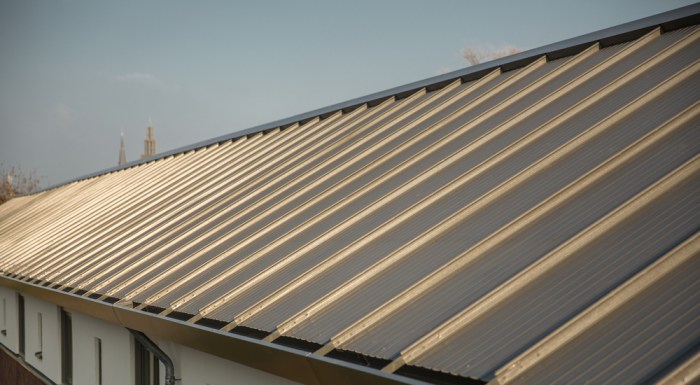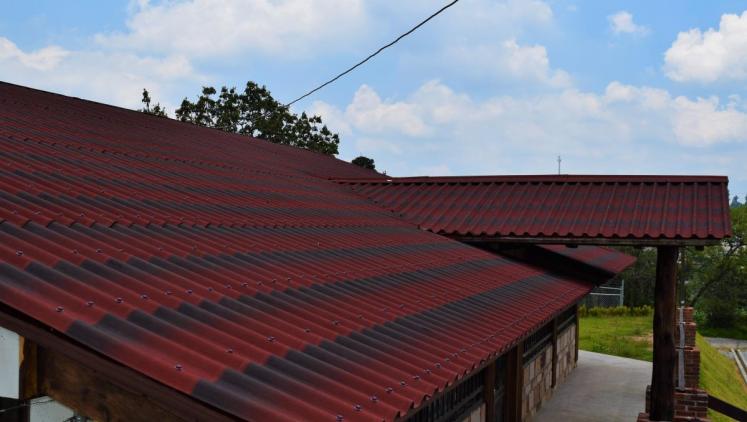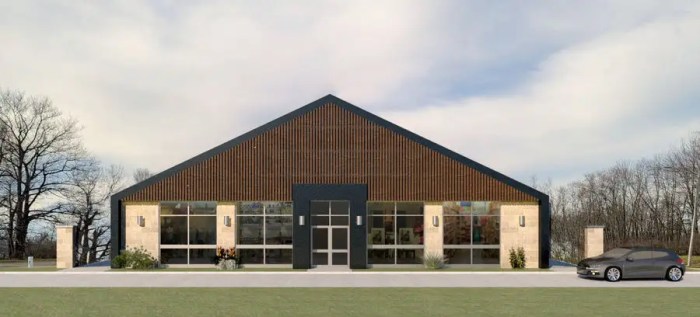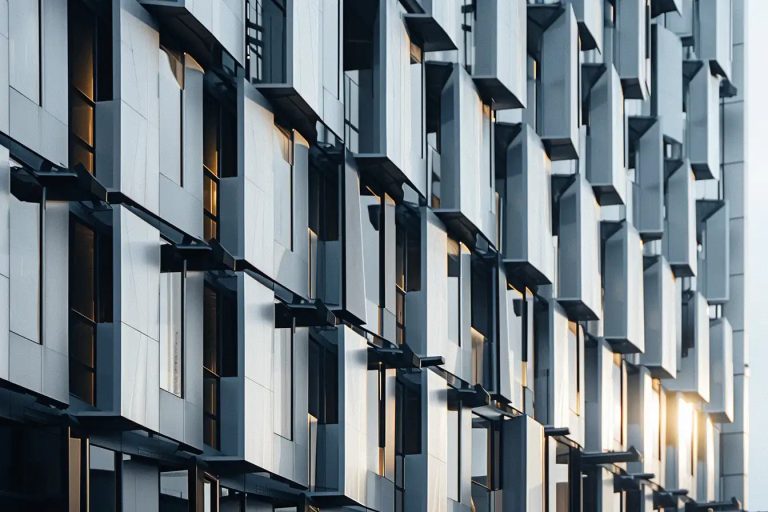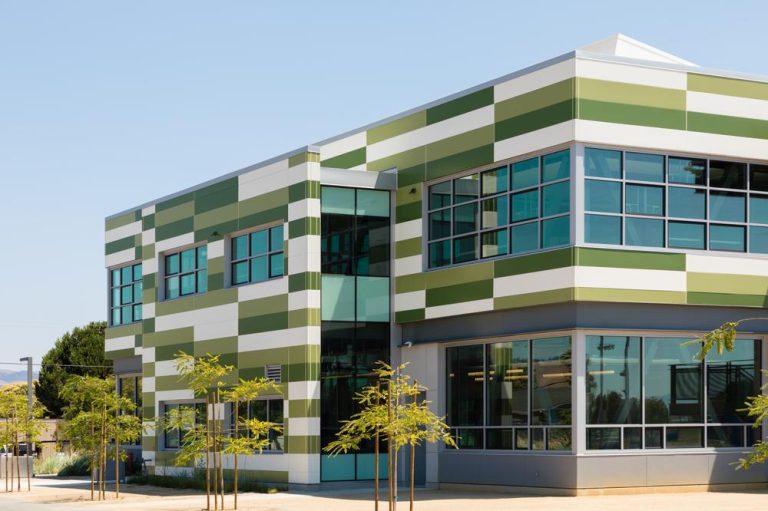Copper Color Metal Roof Panels A Complete Guide
Copper color metal roof panels offer a striking blend of durability and aesthetics. Their rich, warm hue complements a wide range of architectural styles, from rustic farmhouses to modern minimalist designs. This guide dives deep into everything you need to know about these attractive and long-lasting roofing solutions, covering everything from installation and maintenance to cost considerations and environmental impact. Get ready to explore the world of copper-colored metal roofing!
We’ll examine the material properties, delve into installation best practices, and compare the long-term costs and benefits against other roofing options. We’ll also discuss the environmental considerations and explore the many ways copper color metal roofing can enhance your home’s curb appeal and value.
Copper Color Metal Roof Panel Aesthetics
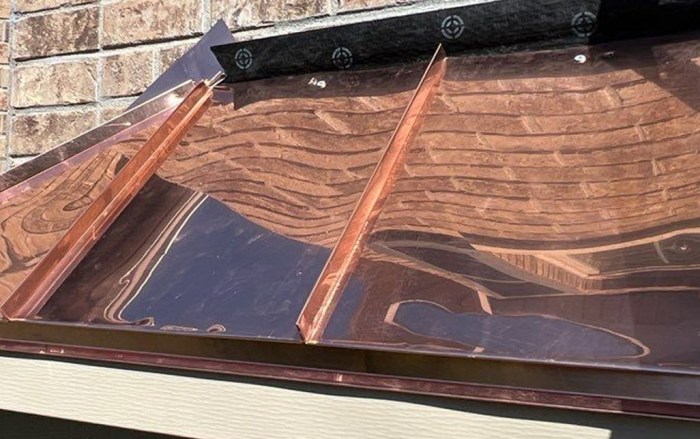
Source: vortexmetalfab.com
Copper color metal roofing offers a unique and sophisticated aesthetic that can enhance the visual appeal of a home, regardless of its architectural style. Its warm, metallic tones provide a distinct contrast to more common roofing materials, adding a touch of elegance and timeless charm. The subtle color variations, influenced by oxidation and weathering, contribute to a dynamic and ever-evolving visual effect.
Copper’s Visual Appeal in Different Architectural Styles
Copper’s versatility allows it to complement a wide range of architectural styles. In traditional homes, its rich color can evoke a sense of history and craftsmanship, complementing brick or stone facades. Modern homes, with their clean lines and minimalist designs, benefit from the sleekness and sophistication that copper provides, creating a striking contrast against lighter-colored walls. Even rustic or farmhouse styles can be beautifully enhanced with copper roofing, offering a warm and inviting aesthetic. The warm tones of copper can also be a beautiful counterpoint to the cool tones of many modern materials. For example, a copper roof on a house with steel or aluminum siding can create a sophisticated, balanced look.
Comparison of Copper with Other Popular Roofing Colors
Compared to the more common gray or brown roofing options, copper offers a distinct visual advantage. Gray roofs, while neutral and versatile, can sometimes appear bland or uninspired. Brown roofs, while more earthy and warm, can sometimes lack the unique visual character of copper. Copper’s inherent reflectivity and changing patina contribute to a dynamic visual experience, unlike the static nature of many other colors. The gradual shift in color from a shiny reddish-brown to a darker, more verdigris tone over time adds depth and character to the roof, creating a unique visual story. This contrasts with the consistent appearance of gray or brown roofs, which tend to remain relatively unchanged over time.
Reflectivity and Heat Absorption Properties
The following table compares the reflectivity and heat absorption properties of copper color metal panels against gray and brown metal roofing. Note that these values are approximate and can vary based on the specific alloy and finish of the metal. Higher reflectivity indicates less heat absorption, leading to potential energy savings.
| Roofing Color | Solar Reflectance (Approximate) | Heat Absorption (Approximate) | Notes |
|---|---|---|---|
| Copper | 0.25 – 0.40 | High (initially); decreases with patina | Reflectance varies with patina; initially, high heat absorption, which decreases over time. |
| Gray | 0.30 – 0.50 | Medium to Low | Generally good reflectivity; consistent performance over time. |
| Brown | 0.20 – 0.35 | Medium to High | Lower reflectivity than gray; relatively consistent performance over time. |
Material Properties and Durability
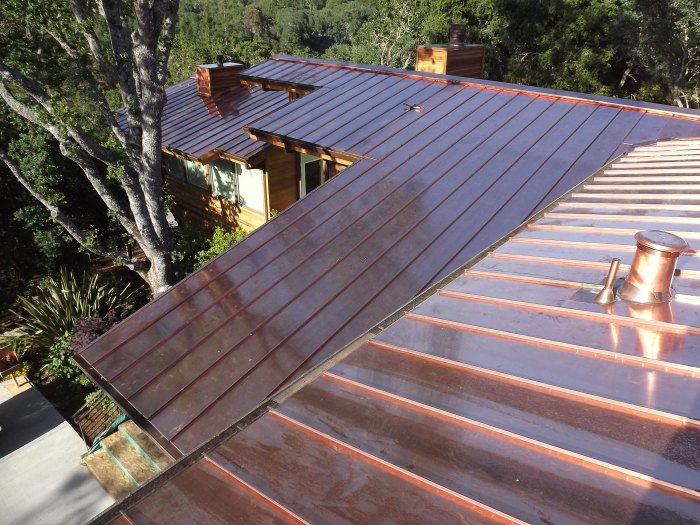
Source: metalroofsystemsinc.com
Copper color metal roof panels aren’t made of copper; the “copper” appearance is achieved through various methods, resulting in different material properties and levels of durability. Understanding these differences is key to making an informed decision about your roofing project.
Let’s explore the composition and long-term performance of these panels.
Composition of Copper Color Metal Roof Panels
Copper color metal roofing typically uses steel as its base material. This steel is then coated to achieve the desired copper look. Common coating methods include painting with a copper-colored acrylic or polyester paint, applying a metallic coating that mimics the appearance of copper, or using a zinc-aluminum alloy coating (Galvalume) followed by a copper-colored paint for added protection and color consistency. The specific composition significantly impacts the panel’s durability and longevity. For instance, a thicker paint layer will generally offer better protection against fading and chipping than a thinner one. Similarly, the type of steel used (e.g., galvanized steel) affects its resistance to rust and corrosion.
Corrosion Resistance and Longevity
The corrosion resistance of copper color metal roofing is primarily determined by the coating’s quality and thickness, as well as the underlying steel’s properties. While not as inherently corrosion-resistant as actual copper, properly coated steel panels can offer significant longevity. A high-quality coating can protect the steel from oxidation and environmental factors for many years, often exceeding 50 years with proper maintenance. This contrasts with asphalt shingles, which typically last 15-30 years, and wood shakes, which may last only 20-30 years, needing more frequent replacements. The actual lifespan will depend on several factors, discussed below.
Environmental Factors and Long-Term Performance
Various environmental factors significantly influence the long-term appearance and performance of copper color metal roof panels. Coastal areas with high salinity levels can accelerate corrosion, especially if the coating is damaged. Areas with heavy industrial pollution may expose the panels to acidic rain, which can degrade the coating over time. Extreme temperature fluctuations, common in climates with harsh winters and hot summers, can cause expansion and contraction of the metal, potentially leading to paint cracking or delamination. UV radiation from sunlight can also fade the color of the coating, causing it to lose its vibrant copper hue over time. Regular cleaning and maintenance can mitigate some of these issues, prolonging the life and aesthetic appeal of the roof. For example, in a coastal environment, regular washing with fresh water can remove salt deposits that accelerate corrosion. In areas with heavy pollution, more frequent cleaning may be necessary.
Installation and Maintenance: Copper Color Metal Roof Panels
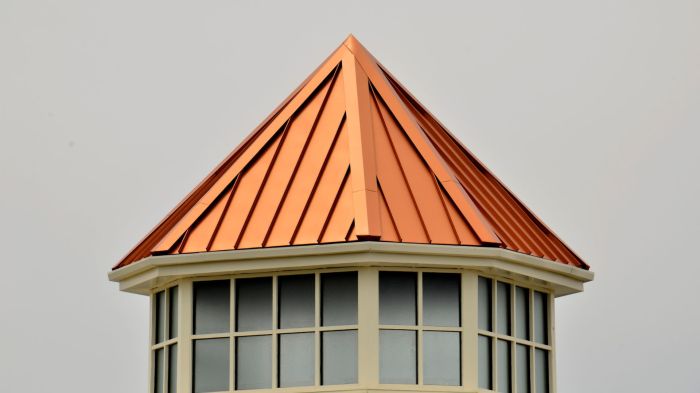
Source: ctroofing.contractors
Installing a copper color metal roof is a significant undertaking, best left to experienced professionals unless you possess substantial DIY skills and are comfortable working at heights. Proper installation ensures the longevity and aesthetic appeal of your new roof. Neglecting proper installation can lead to leaks, premature wear, and costly repairs. This section details the process and crucial maintenance practices.
Tools and Safety Precautions for Copper Metal Roof Panel Installation, Copper color metal roof panels
Before beginning any installation, prioritize safety. Working on a roof is inherently dangerous. Always use appropriate safety equipment, including a harness, safety line, and sturdy footwear with good grip. Have a spotter assist you whenever possible. Necessary tools include: measuring tape, metal shears or a circular saw with a metal-cutting blade, roofing screws, sealant, safety glasses, work gloves, a ladder (or scaffolding for larger roofs), and possibly a crane for larger panels. Always follow the manufacturer’s instructions for your specific panels and roofing system. Ensure all tools are in good working order and appropriate for the task.
Step-by-Step Installation Guide for Copper Color Metal Roof Panels
A typical installation involves several key steps. First, prepare the roof deck, ensuring it’s clean, dry, and free of debris. Next, install underlayment, which acts as a secondary water barrier. Then, begin installing the metal panels, starting at the lowest point of the roof and working your way up. Overlap panels according to the manufacturer’s specifications, typically a few inches. Secure panels with roofing screws, ensuring they’re driven straight and tight to avoid leaks. Apply sealant to all seams and penetrations to prevent water infiltration. Finally, install any necessary trim pieces, such as ridge caps and flashing, to complete the installation. Remember to regularly check your work for accuracy and proper alignment.
Cleaning and Maintaining Copper-Color Metal Roofs
Regular cleaning helps maintain the beauty and lifespan of your copper metal roof. At least once a year, inspect the roof for any damage, loose panels, or debris buildup. Use a soft-bristled brush or a pressure washer (on a low setting) to remove dirt, leaves, and other debris. Avoid harsh chemicals or abrasive cleaners, as they can damage the finish. For stubborn stains, a mild soap solution can be used, followed by a thorough rinsing with clean water. Addressing minor issues promptly prevents them from escalating into larger, more expensive problems. For example, a small leak ignored could lead to significant structural damage.
Regular Roof Inspection Checklist
A regular inspection is crucial for proactive maintenance. This checklist will help you identify potential problems:
- Check for any loose or damaged panels.
- Inspect seams and flashing for any signs of leaks or sealant failure.
- Look for signs of rust or corrosion, particularly around fasteners.
- Examine the gutters and downspouts for clogs or damage.
- Check for any signs of moss or algae growth.
- Inspect the roof for any signs of damage from weather events, such as hail or strong winds.
Addressing issues promptly, as noted in the cleaning and maintenance section, is essential to preserving your roof’s integrity. A small problem today could become a costly repair tomorrow.
Cost and Value Considerations
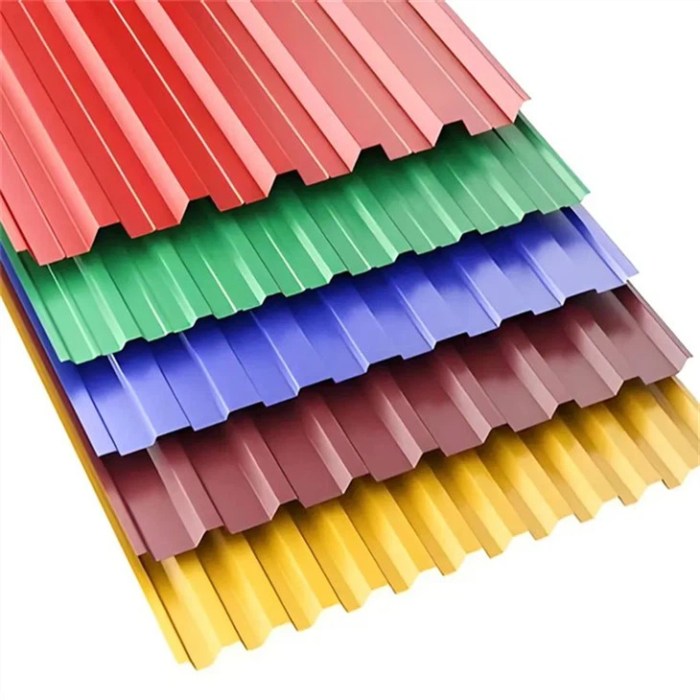
Source: lumeisteel.com
Choosing a roof is a significant investment, and understanding the cost implications alongside the long-term value is crucial. Copper color metal roofing, while initially more expensive than some alternatives, offers compelling long-term benefits that often outweigh the higher upfront cost. Let’s delve into a detailed comparison to help you make an informed decision.
The initial cost of a copper color metal roof is higher than that of asphalt shingles or even some less expensive metal roofing options. However, comparing it to materials with similar aesthetic appeal, like actual copper roofing or high-end clay tile, reveals a potentially more favorable picture. While genuine copper roofing boasts exceptional longevity and visual appeal, its price point is considerably higher. High-quality clay tile roofs also command a premium, often rivaling or exceeding the cost of a copper color metal roof. The key difference lies in the long-term value proposition.
Copper Color Metal Roofing Cost Compared to Similar Aesthetics
Let’s illustrate with a hypothetical example. Assume a 2000 square foot roof. Asphalt shingles might cost $8,000-$12,000 for materials and installation, while a copper color metal roof could range from $15,000-$25,000, depending on the chosen panel type and installer. Genuine copper roofing, however, could easily exceed $30,000, and high-end clay tile might fall within a similar price range. While the initial investment is higher for the metal roofing, it’s significantly less than the cost of a full copper roof.
Long-Term Cost Savings
The long-term cost savings associated with copper color metal roofing stem from several factors. Firstly, its exceptional durability significantly reduces the need for frequent repairs and replacements, unlike asphalt shingles, which may need replacing every 15-20 years. Secondly, many metal roofs offer superior energy efficiency, reflecting sunlight and reducing cooling costs. Thirdly, the lower maintenance requirements translate to fewer ongoing expenses.
Return on Investment (ROI) of Copper Color Metal Roofing
Predicting the exact ROI requires several assumptions about lifespan, maintenance costs, and energy savings, but we can illustrate a potential scenario. The following table presents a simplified example, focusing on a 50-year lifespan for the metal roof (a conservative estimate). Actual figures will vary based on location, climate, and specific product choices.
| Year | Material & Installation Cost | Annual Maintenance | Annual Energy Savings (estimated) |
|---|---|---|---|
| 0 | $20,000 | $0 | $0 |
| 1-50 | $0 | $50 (average annual) | $200 (average annual) |
In this example, the total cost of maintenance over 50 years is $2500, offset by estimated energy savings of $10,000. The net cost after 50 years is $12,500, representing a significant savings compared to replacing asphalt shingles multiple times over the same period. This illustrates the potential for a positive ROI, though actual figures will vary.
Environmental Impact
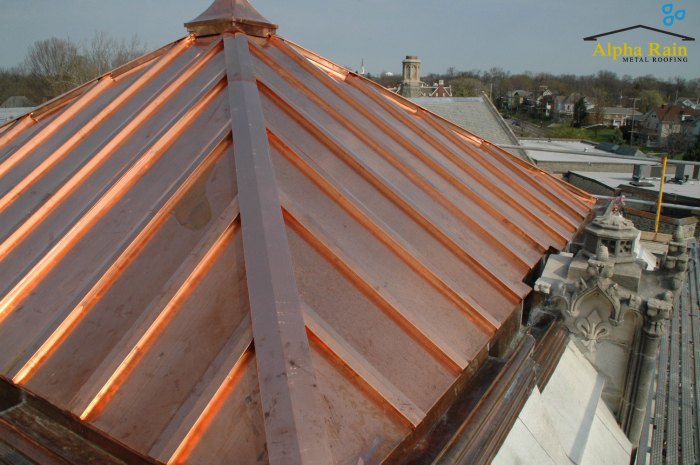
Source: alpharain.com
Choosing a roofing material has significant environmental implications, extending far beyond the initial purchase. Copper color metal roofing, while offering many aesthetic and performance advantages, presents a unique environmental profile compared to asphalt shingles, clay tiles, or other options. Let’s explore its lifecycle impact.
Copper color metal roofing’s environmental footprint is complex, encompassing manufacturing, transportation, installation, use, and ultimately, disposal. Understanding these stages helps in evaluating its overall sustainability.
Recyclability and Sustainability
Copper, the primary component influencing the “copper color” in these panels (often achieved through a coating or alloying process), is highly recyclable. Unlike asphalt shingles, which often end up in landfills, copper can be repeatedly melted down and reused with minimal loss of material properties. Steel, another common base material for metal roofing, also boasts excellent recyclability. This inherent recyclability contributes to a reduced demand for virgin materials, lessening the environmental burden of mining and refining processes. The sustainability of copper color metal roofing is further enhanced when manufacturers utilize recycled content in their panel production. For example, a significant portion of the steel used in many metal roofing products originates from recycled sources.
Manufacturing and Disposal Impacts
The manufacturing process of metal roofing panels involves energy consumption, primarily for steel production and coating applications. However, the longevity of metal roofs significantly offsets this initial energy investment. The energy used to manufacture and transport asphalt shingles, for instance, is often higher over the shorter lifespan of the material. Disposal of copper color metal roofing panels is relatively straightforward due to their recyclability. Proper dismantling and sorting of the materials (steel, copper coating, and any other components) allows for efficient recovery and reuse, minimizing landfill waste. However, improper disposal can lead to environmental contamination, particularly if coatings contain hazardous substances. Responsible disposal practices are crucial for mitigating these potential risks.
Energy Efficiency
Copper color metal roofs, and metal roofs in general, exhibit superior energy efficiency compared to many alternative roofing materials. Their high reflectivity (albedo) helps to reduce the amount of solar heat absorbed by the building. This leads to lower cooling loads, reducing energy consumption for air conditioning, and subsequently decreasing greenhouse gas emissions. Moreover, metal roofing’s thermal properties can contribute to improved insulation, reducing heating needs in colder climates. The extent of energy savings depends on factors such as the roof’s color, surface texture, climate, and building design. For example, a light-colored metal roof in a hot climate will yield more significant energy savings than a dark-colored one in a temperate climate. Studies have shown that metal roofs can significantly reduce a building’s energy consumption, contributing to a smaller carbon footprint.
Design and Architectural Applications
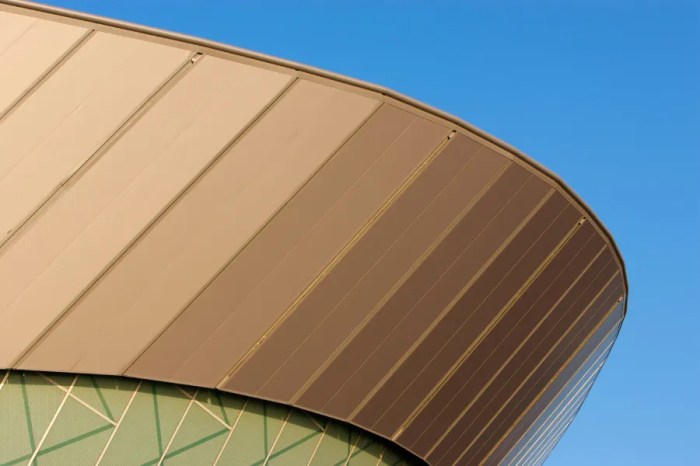
Source: co uk
Copper color metal roofing offers a unique blend of durability and aesthetic appeal, making it a versatile choice for a wide range of architectural styles. It’s rich, warm tone can complement both traditional and contemporary designs, adding a touch of sophistication and timeless elegance. The ability to customize panel profiles and finishes further enhances its design flexibility.
The color and texture of copper-colored metal panels significantly impact the overall building design. The inherent richness of the copper tone can be used to create a focal point, or it can subtly blend into the surrounding landscape depending on the desired effect. The texture, whether smooth or subtly textured, influences how light reflects off the surface, creating different visual experiences throughout the day.
Copper Color Metal Roofing in Various Architectural Styles
The versatility of copper color metal roofing allows for seamless integration into a multitude of architectural styles. Its adaptability ensures that it enhances the overall design rather than clashing with it.
- Modern Architecture: The clean lines and sleek profiles of standing seam copper roofs perfectly complement the minimalist aesthetic often found in modern homes and commercial buildings. The metallic sheen adds a sophisticated industrial touch. Imagine a low-slung, angular structure with a standing seam copper roof reflecting the sunlight, creating a dramatic and modern statement.
- Traditional Architecture: Copper’s warm tones blend beautifully with the earthy colors commonly found in traditional styles such as Craftsman, Victorian, or Farmhouse designs. A corrugated copper roof on a charming farmhouse, for example, creates a rustic yet refined look, while complementing brick or stone facades. The slightly rougher texture of corrugated panels can create a sense of aged patina, further enhancing the traditional aesthetic.
- Rustic Architecture: The natural aging process of copper, where it develops a verdigris patina, is a particularly desirable characteristic for rustic designs. This natural weathering process adds character and depth to the roof, complementing the rough-hewn timbers and stonework often associated with rustic architecture. Imagine a mountain cabin with a gently sloping roof of copper, gradually developing a deep green patina over time, seamlessly blending into the surrounding natural environment.
Incorporating Copper Color and Texture into Building Design
The copper color’s warmth can be echoed in other building materials, such as brick, stone, or wood siding, creating a cohesive and visually appealing design. The texture of the panels can be considered about other surface textures on the building to maintain a balanced and harmonious look. For instance, a smooth copper roof might pair well with smooth stucco walls, while a textured copper roof could complement a rough-hewn stone facade.
Impact of Different Roof Profiles on Appearance
The choice of roof profile significantly influences the visual impact of a copper color metal roof.
- Standing Seam: Standing seam roofs create clean, sharp lines, emphasizing the modern and sleek aspects of the copper color. The uninterrupted lines of the panels offer a sophisticated, minimalist appearance.
- Corrugated: Corrugated profiles add texture and a more rustic or industrial feel. The repeating pattern of the corrugations adds visual interest and can create a more dynamic appearance, particularly when viewed from different angles. The shadows cast by the corrugations further enhance the visual depth and texture.
Ultimate Conclusion
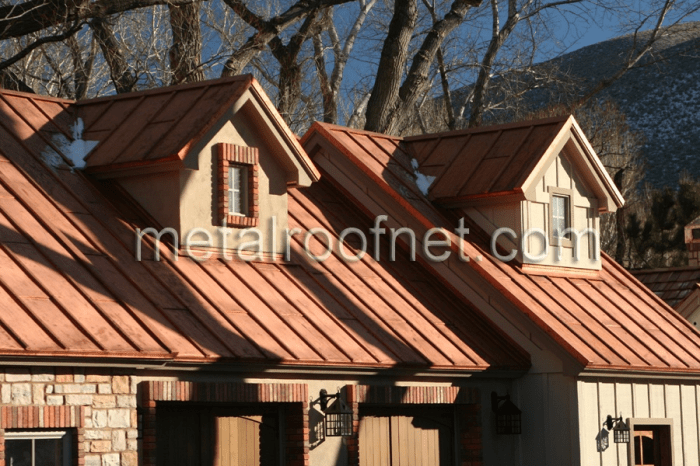
Source: metalroofnet.com
Choosing the right roofing material is a significant investment, and copper color metal panels present a compelling option. Their durability, aesthetic appeal, and relatively low maintenance requirements make them a smart choice for homeowners looking for a long-lasting, attractive, and environmentally conscious roofing solution. By understanding the nuances of installation, maintenance, and cost, you can confidently make an informed decision that enhances your home’s beauty and value for years to come. Remember to always consult with qualified professionals for installation and any complex repairs.
